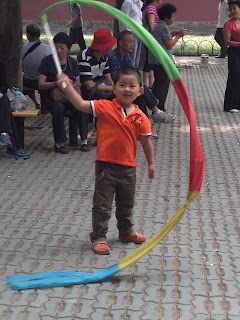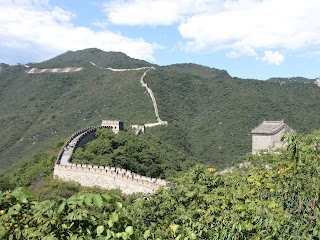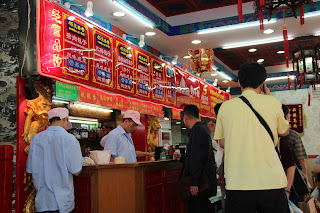So I left off with our seeing the Great Wall outside of Beijing. Our guide, Andy, grew up in Beijing, in a hutong, which is an old-fashioned village still inside Beijing. There are still a few of these little neighborhoods, glimpses into life in Beijing thirty or forty (or even longer) years ago. He and our driver were kind enough to drop us off at the closest one to Andy's old home hutong, which no longer exists.
 |
| In the hutong. Lots of narrow streets and motorcycles. |
It was a little like Tian Zi Fang in Shanghai, in that it was just a maze of buildings with shops, restaurants, and PEOPLE everywhere. Unlike Shanghai, though, these were one-story buildings, long and low. This particular hutong had survived because, behind the buildings and off the main street, was a lake:
There were scores of restaurants and bars, and even rickshaws, all around the lake. Further up was a residential area of the hutong. The further you got from the shops, the nicer the houses were--some looked like much more recent construction. Others, well, we could be pretty certain the electrical inspections had been overlooked:
We enjoyed our long walk in the hutong, which was peaceful by Beijing standards. But for dinner we headed back to the main shopping district near our hotel, Wangfujing Street, and QuanJuDe, THE place for Peking duck!
I can't tell you how much I wish I had pictures. I was so busy enjoying myself that I totally forgot to take any! Peking Duck is one of those dishes I'd always heard about but never had, and QuanJuDe is a five-story temple to this very famous dish. All they sell is duck in its various roasted dishes. The chef takes your order (Duck? Or duck?), and after quite a wait they wheel your dish out to you on a cart. We had ordered a couple of vegetable dishes to go with the duck, but they are clearly second place to the star in this restaurant. For the four of us we ordered just one duck. It was a good thing.
The chef presented us with a certificate of authenticity, telling us where the duck lived before arriving on our dinner table. You can even look it up on the internet...or you COULD, if I had saved the card. (One of the hazards of blogging about something four months later.) He then carved the bird precisely, finishing with the head sliced neatly in two.
To eat the duck, you place a few slices on a pancake-like piece of bread, top it with some duck sauce and scallions, and pop it in your mouth. YUM. I'm not really a duck fan, but this was terrific. The duck is so rich that I can only eat a couple of bites. After we were done with the meat, the chef brings out a broth made from the duck carcass. The richness of the duck is even more obvious--it was like drinking melted butter!
The next day we explored the Forbidden City. Huge does not begin to describe it. You enter through a gate, then pass a temple, then through another gate, then a temple, then...it all starts to look the same! Everything is huge, and yet it is all empty. There isn't anything to give you an idea of the life of a courtier or official or servant, or even the emperor himself except for a couple of reproduction thrones. Every bit of original furniture or clothing was pulled out of these buildings during the Cultural Revolution and burned--all of it. No robes, no tea sets, no chairs. Just empty buildings.
 |
| The throne room. These are reproductions. The calligraphy would have been done by the Emperor himself. |
 |
| The view from the back of the Forbidden City up to a Temple behind the gardens. This temple is in a separate set of gardens from the Forbidden City itself. |
Behind the final temple is a garden. This is where the empress and the concubines spent most of their time. I certainly wouldn't call it beautiful but it seemed to be the most comfortable part of the Forbidden City. The water and huge old cypresses made for a less "forbidding" atmosphere.
Our last stop in Beijing was the Heavenly Temple. This is a former Taoist temple used by the emperors, but now it is just a park and tourist site. The park is very heavily used by Beijing residents; many people come there to perform all sorts of songs, dances, or even rhythmic gymnastics. And they seem to welcome participants.
 |
| This little guy had the best time with these ribbons! |
The temple sits in front of a mound, a set of three concentric circles, each with nine steps. At the center of the top mound is a large, round stone. If you go to the China exhibit at Epcot you can actually see a reproduction of this.
 |
| The front part of the park and temple. The raised part is a lot further back. |
 |
| I am standing on the raised mound here, looking back toward the temple above. That temple is the far one in this picture. |
 |
| Gratuitous picture of myself that I like. Taken at the temple park area, though. Check out the hazy sky! |
Again, though, there isn't a sense of history at all about this place. It is just that, a place, with some lovely painting and interesting carved stone. There isn't any human feel to it in the least. The people in the surrounding park were enjoyable, but they could have been anywhere. There just felt like a disconnect between what the place used to be and what it is--in a way that I didn't feel in Europe. A sense that history broke at some point in the recent past.
One final note about Beijing: the traffic is without a doubt the worst I've ever seen. Do NOT take a cab, ever. The subway is clean, fast, and cheap--only about 37 cents per ride! We learned our lesson after taking 90 minutes to go about six miles one day.
 |
| Bill enjoying some regional sweets: a coconut milk popsicle and candy-coated strawberries. Actually, the strawberries were mine but they are so sweet you can only eat one or two. |
One more day to talk about, coming up...






















































